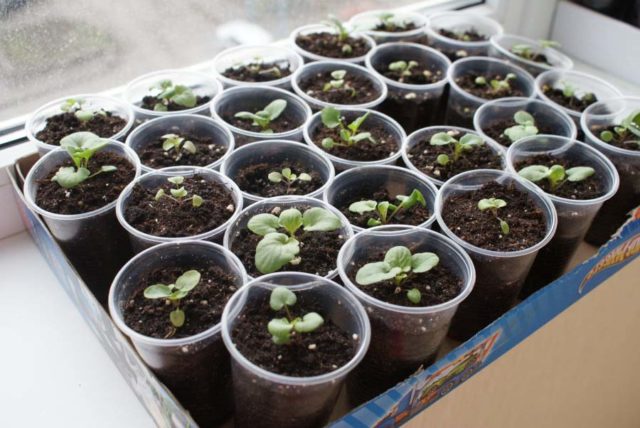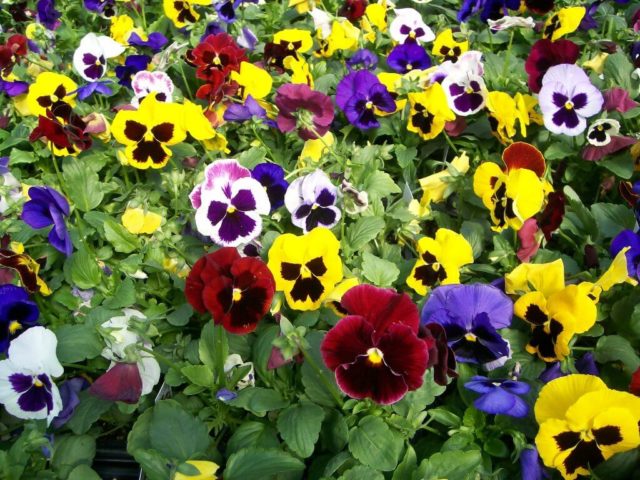Content
Viola Swiss giants is an unpretentious biennial that attracts attention in any flower bed with its large, bright inflorescences. Ideal for decorating suburban areas, park areas, terraces and balconies. In order for the plant, which is popularly called pansies, to bloom long and profusely in the summer months, in the spring it is important to sow the seeds correctly and grow seedlings.
Description of the viola Swiss giants
The genus Viola includes almost 500 species of perennial, biennial and annual plants. One popular variety is called Swiss giants. It belongs to the Wittrock viols. The variety fully justifies its name “giants” with lush inflorescences, contrasting with the small size of the bushes.
The plant is herbaceous, compact. Its height reaches 15–35 cm. Leafy viola bushes Swiss giants are distinguished by their unpretentiousness. They tolerate low temperatures well, but require regular and abundant watering. They can grow in open spaces with a lot of sunlight, or in partial shade. In the latter case, flowering is less abundant.
Viola Swiss giants prefers moist, loamy, fertile soils.Plants planted on dry sandy soils produce small flowers. In areas where water often stagnates, they rot.
Features of flowering
The flowers of the Swiss giants variety are large, of various bright colors: white, yellow, red, blue, violet, lilac, burgundy. The diameter of the inflorescences can reach 8-10 cm. A special feature is the different color of the center of the flower and the main shade of the petals. Photo of viola Swiss giants demonstrate the presence of a dark “eye” in the center and a “butterfly” border located along the edges of the petals.
Application in design
Swiss giant violas are a prime example of ornamental plants that combine well with other perennials. Expressive compositions are made up of pansies, planted in large numbers in the flowerbed. They create a beautiful carpet of colorful petals and green foliage. To make it more spectacular, you can dilute the planting of tricolor violets with early flowering crops, such as crocuses or scillas.
Viola Swiss giants is used in landscape design to create alpine slides, flower beds, and border plantings. The best companions for this culture are daisies, forget-me-nots, and tulips. To emphasize the beauty and richness of the color of pansies, they are planted against the background of dwarf conifers and ornamental shrubs.
Due to its unpretentiousness, this species is often used as a potted crop. Violas are easy to grow on terraces, window sills, garden beds, and balconies.
Features of reproduction
Viola reproduces in several ways:
- Cuttings. This method is suitable for breeding valuable varieties and allows you to rejuvenate plants.
- Seeds. The Swiss Giants variety demonstrates a germination rate of over 80%. To ensure that the plants bloom in the year of planting, the seeds are planted in seedling containers in early spring. The buds bloom already in June. When grown as a biennial, the seeds are sown after ripening and flowering begins the following year.
Growing seedlings
It is not difficult to grow Swiss giant viola seedlings from seeds, since the variety is unpretentious. The best time for sowing is early spring. Seeds are grown as follows:
- Prepare containers for seedlings, fill them with fresh loose soil.
- Planting material is sown and lightly sprinkled with soil.
- The containers are covered with glass or film to create a greenhouse and placed in a room where the temperature is maintained from +20 to +25 degrees.
- The shelter is removed several times a day to ventilate the plantings.
- The soil is moistened as it dries.
- The first shoots usually appear after 7-15 days.
- The shelter is removed, as the sprouts need good lighting. Containers with seedlings are placed near the window.
- After 1-2 pairs of true leaves appear, the plants are planted in separate pots, deepening to the cotyledon leaves.
The substrate for seedlings can be purchased in stores, or you can prepare it yourself from peat, humus and garden soil enriched with nutrients. They must be mixed in equal parts.

After several true leaves appear, the viola is pinched so that the plants grow well.
Landing in the ground
Swiss giants viola seedlings are planted in the ground after the end of spring frosts, in May.The culture feels comfortable in well-lit areas, protected from the sun at midday, under sparse tree crowns.
Viola seeds can also be sown in the ground. Planting is carried out at the end of spring or with the onset of June. They do this as follows:
- Grooves are marked in the soil at a distance of 20 cm from each other. Their depth should be small, about 1 cm.
- The seeds are lightly sprinkled.
- The soil is well shed.
- When the first true leaves appear, they are pinched off.
Aftercare
Viola Swiss giants is a biennial plant. But if not properly cared for, it produces buds and flowers within one season. Despite the unpretentiousness of the crop, certain agricultural operations should be performed regularly. Abundant flowering can be achieved by the following measures:
- frequent loosening of the soil (the root system of the flower is shallow and needs oxygen);
- weeding;
- regular watering, viola is a moisture-loving crop;
- removal of dried inflorescences and seed pods, which must be done once a week so that the plant does not become depleted and continues to bloom;
- fertilizing once a month to feed adult specimens and once every 10 days for seedlings (liquid complex mineral compounds, superphosphate or ammonium nitrate are preferred);
- winter shelter with spruce branches, leaves or straw.

Despite the winter hardiness of the variety, it must be covered to preserve the root system.
Pests and diseases
Viola Swiss giants is not one of the varieties susceptible to diseases. Most often, it shows sensitivity to fungus; the most common diseases are powdery mildew and blackleg. The reasons for their development are usually associated with violations of agricultural technology.
Disease | Causes and symptoms | Treatment options |
Powdery mildew | It appears as a white or grayish coating covering the stems, leaves and buds of the viola. It occurs due to the application of exclusively nitrogenous fertilizers, or in dry, hot weather with heavy morning dew. | Spray the affected bushes of the Swiss giants with Fundazol, a soap solution with soda ash. Carry out the treatment twice with an interval of 14 days. |
Gray rot, black leg | It develops under unsuitable growing conditions: temperature, soil and air moisture. | Diseased plants cannot be saved and must be removed to prevent further infection of healthy plants. Water the soil with Fundazol. |
spotting | It manifests itself in the fact that the leaves of the viola begin to dry out, and the viola itself becomes lethargic and weak. | Destroy and burn the affected bushes of the Swiss giants. Spray neighboring plants with Bordeaux mixture for preventive purposes. Carry out this procedure three times with a break of 2 weeks. |
Insects that pose a danger to the Swiss giant viola are the clover owl, aphids, and violet mother of pearl. They eat the foliage of plants. To control pests, use chlorophos or tobacco infusion.
Conclusion
Viola Swiss giants are an unpretentious inhabitant of parks, suburban areas, terraces, and balconies. By following the basic rules of agricultural technology when growing, you can enjoy bright, multi-colored compositions throughout the summer months.









